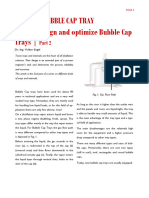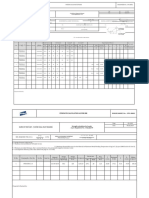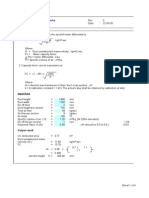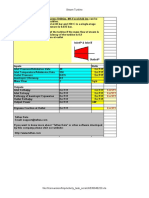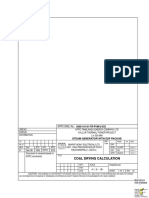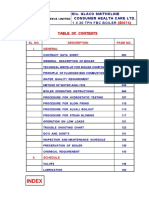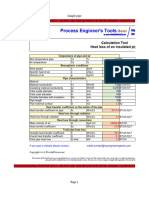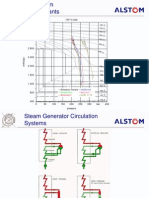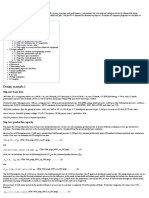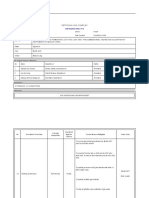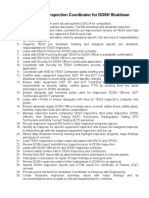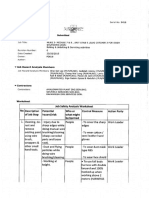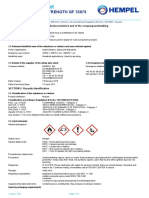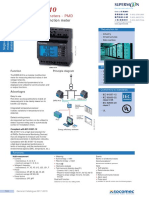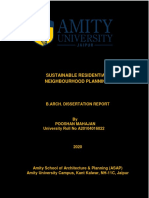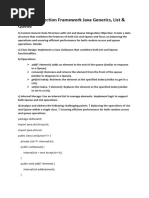Fired Boilers: 2.1 Design Principles
Fired Boilers: 2.1 Design Principles
Uploaded by
Eric TingCopyright:
Available Formats
Fired Boilers: 2.1 Design Principles
Fired Boilers: 2.1 Design Principles
Uploaded by
Eric TingOriginal Description:
Original Title
Copyright
Available Formats
Share this document
Did you find this document useful?
Is this content inappropriate?
Copyright:
Available Formats
Fired Boilers: 2.1 Design Principles
Fired Boilers: 2.1 Design Principles
Uploaded by
Eric TingCopyright:
Available Formats
OG.04.
20576 1 Confidential
2. FIRED BOILERS
2.1 DESIGN PRINCIPLES
2.1.1 Steam and Water System of the Fired Boiler
The “process flow diagram” of a fired steam boiler, Fig. 1 is divided into four main parts:
• the economiser,
• the steam drum,
• the evaporator,
• the superheater.
Typical conditions at
outlet evaporator 350 °C
3-10% Wt steam 23.5 Bar
97-90% Wt water
Temp °C
“ Steaming” 25.5 Bar 225 °C
ECO
185 °C A
140 °C Non steaming
27.5 Bar
Water Water-steam Steam Coil length
Economiser Evaporator Super heater
Steam Drum 50 t/h
Superheater
A 55 t/h water 1100 t/h water
1045 t/h steam
Economiser 1 t/h blow down
51 t/h Risers
Evaporator Downcomers
Fig. 1 “Process Flow Diagram” of a Natural Circulation Boiler 0009-0
The boiler is supplied with feed water by a boiler feed pump and it passes through the
economiser to the steam drum. The economiser is a tube bundle located in the coolest part of the
boiler’s flue gas side, just upstream of the flue gas stack. In the economiser, the feed water is
heated up to a temperature close to, or even equal to the saturation temperature of the boiler
water, Fig 1. Then the feed water enters the steam drum through a perforated distribution pipe
where it mixes with boiler water rising from the evaporator.
The mixed boiler water leaves the steam drum through the boiler downcomer pipes which feed
into the evaporator riser tubes via bottom headers or a bottom water drum. In the evaporator
tubes, heat is applied and the water partly vaporises on its return journey to the steam drum. The
flow of boiler water through the evaporator, in this case, is achieved by natural circulation.
In some boilers there may be two different evaporator sections equipped with riser tubes. Firstly
there is always a cooled radiant section where the heat from the burner flames is transferred by
radiation.
WUDG – Vol I. Energy and Power Systems – Boiler details
OG.04.20576 2 Confidential
Secondly, in some cases only, there is an evaporative convection bank, located as a vertical tube
bundle connecting the steam (top) and water (bottom) drums, Fig. 2.
Steam drum Saturated steam
to superheater
Blowdown
Boiler feed
Water
Section A-A Flue gas to stack
Boilerbank
A A Downcomers
Risers
Risers
Burners
Waterdrum
0022-0
Fig. 2 Horizontally Fired Bi-drum Boiler (Superheater Omitted)
From the top of the evaporator, the mixture of water and steam rises into the steam drum. Here,
the steam is separated from the water and dried by means of cyclones or baffle plates and
demisters. Some of the steam generated in the evaporator condenses in the steam drum in order
to heat the incoming feed water up to the saturation temperature of the boiler water.
The dried saturated steam leaves the steam drum through a pipe at the top and flows through the
superheater tube coils where it is heated up to its final process temperature. A constant steam
temperature at varying boiler loads is obtained by use of condensate spray desuperheating. To
reduce the metal temperature of the superheater outlet tubes, the superheater is often divided
into a primary and a secondary section with the desuperheater located in between, Fig. 3.
WUDG – Vol I. Energy and Power Systems – Boiler details
OG.04.20576 3 Confidential
Superheaters
Condensate injection
TC
Flue gas
Steam Drum
Blowdown
Economizer
Unheated
Section A -A A downcomer
Feed water
Furnace wall
Burners To Stack
Fig. 3 Horizontally Fired Single Drum Boiler 0005-0
2.1.2 Evaporator Sections
Fired boilers are available with different types of water circulation systems, for example natural
circulation, once-through, forced and assisted circulation. The natural circulation system,
however, is typical for the utility boilers used in Shell Group Refineries. Boilers with forced
circulation systems are discussed in Part II which deals with SIOP-type Waste Heat Boilers.
In natural circulation, the mixture of water and steam in the evaporator rises because it has a
lower density than the water supplied in the unheated or cooler downcomer tubes. In refinery
boilers, around 3% to 10% by mass of the circulated water is vaporised within the evaporator
tubes. In other words, the circulation ratio (CR), defined as the mass of water and steam
circulating to the mass of steam generated, is between 11 and 34. When the boiler load changes,
the steam generation rate changes and the CR adapts automatically to the prevailing conditions.
The objective of the boiler designer is to ensure that the evaporator tubes are effectively cooled
by nucleate boiling under all operating loads. This requires a well designed system for distribution
of water to each heated tube so that there is adequate cooling and there is no risk of overheating
of tubes due to film boiling, flow segregation, vapour locking, or flow starvation.
As mentioned above, there may be two different types of evaporator sections depending on the
type of boiler, these are the radiant section and the evaporative convection bank.
WUDG – Vol I. Energy and Power Systems – Boiler details
OG.04.20576 4 Confidential
Radiant Section
The walls of the radiant section are built from vertical riser tubes of 2 to 3 inches diameter. Boiler
water from the steam drum is supplied to the bottom of the riser tubes by the downcomer tubes
that are always cooler than the risers and in some boilers are unheated, Figs. 2, 3, 4.
4 x Corner Burners
Fireball
Fig. 4 Tangentially Fired Boiler 0609-0
In the radiant section, a number of (normally) horizontal firing burners are located in one of the
vertical walls, Fig. 2. In the corner- or tangentially-fired boiler, fuel burners are mounted in the four
corners of the radiant section, Fig. 4. In Group Refineries, boilers burn fuel oil and/or fuel gas and
part of the heat liberated within the radiant section is transferred by radiation to the riser tube
walls.
The non-vertical radiant section roof and floor tubes should have sufficient slope to allow proper
water circulation. Floor tubes are often protected from overheating by a layer of fire bricks.
Convective Evaporator
Figures 2 shows the general arrangements of a bi-drum boiler with horizontal burners. Here the
combustion gases have to turn near the radiant section rear wall opposite the burners and then
flow upwards and around an aerodynamic "nose" before reaching the convective evaporator
bank.
This tube bank is a bundle of convection tubes that are connected at the top to the steam drum
and at the bottom to the water drum. The tube bank consists of a number of steam raising riser
tubes located in front of a vertical partition baffle and a number of downcomer tubes located
behind this baffle. The boiler water enters the downcomer tubes at the top and flows by natural
WUDG – Vol I. Energy and Power Systems – Boiler details
OG.04.20576 5 Confidential
circulation through the water drum into the risers of both the boiler bank and the radiant section
walls.
A feature of the bi-drum design is that the downcomers are heated. This requires very careful
design in order to guarantee a positive downflow of non-vaporised water through the downcomers
at all boiler loads. There must be a clear-cut separation between the riser tubes with a high heat
load and the downcomer tubes with a lower heat load. Otherwise there would be a transition zone
with tubes that have no cooling flow. Such tubes would be overheated and would very soon fail.
The single-drum boiler, Figs. 3 and 4, uses unheated downcomers located outside of the flue gas
path. These consist of a small number of large diameter pipes which feed boiler water from the
steam drum to the bottom headers of the boiler wall tubes.
2.1.3 Steam Drum
Within the steam drum, the first stage of steam separation from the water takes place due to the
density difference between the two phases. Thereafter, the separation of entrained water droplets
from the steam is achieved by two basic methods:
• horizontal or vertical cyclones where centrifugal forces are used;
• baffles that direct the steam flow through a complete reversal of direction in the space above
the water level, thereby losing most of the entrained water.
In both cases a final separation stage is used consisting of a screen separator. This can be a
bank of closely-spaced corrugated plates that directs the steam through a tortuous path and
forces any remaining water droplets against the plates. Alternatively, the separator can be a
demister pad which collects the water droplets on its matrix of twisted wires. In both types of
separator, the water cannot be picked up again by the low velocity steam and it drains down into
the lower part of the drum.
2.1.4 Superheater
The job of the superheater is to take dry saturated steam from the steam drum and superheat it to
the required temperature. As a consequence, the superheater has the highest process and metal
temperatures in the boiler.
The superheater is located in the transition zone between the radiant section and the convection
bank, Fig. 2. It consists generally of a convection superheater (primary section) at the inlet of the
convection section and a radiant/convection superheater (secondary section) at the radiant
section exit.
The heat transfer film coefficient inside the superheater tubes is rather small, therefore the tube
metal temperature is rather high. There are several techniques used to minimise the maximum
wall temperature, for example by placing evaporative shield tubes in front of the secondary
superheater, Fig. 4 or by employing concurrent flow in the secondary superheater, Fig. 3.
WUDG – Vol I. Energy and Power Systems – Boiler details
OG.04.20576 6 Confidential
2.1.5 Economiser
The economiser is a convection tube bank located at the end of the flue gas path in the coolest
part of the boiler, Figs 3 and 4. To avoid the risk of acid corrosion from sulphur-bearing fuels, the
economiser water inlet temperature is nearly always controlled at or above 145°C.
In the bi-drum boiler, the economiser has a smaller duty than it does in a boiler with unheated
downcomers. In the latter case the economiser may be specially designed to produce a small
amount of steam (see "steaming eco" in Fig. 1).
2.1.6 Combustion Systems
For proper boiler design and operation, the following requirements must be met:
(a) The burners shall be designed and arranged such that:-
1. The radiant section walls are symmetrically loaded. This is to ensure an even distribution
of flue gases, circulating boiler water and steam generation;
2. At full boiler load (Maximum Continuous Rating) with one burner out of operation, flames
shall not impinge on the radiant section walls or on the superheater shield tubes;
3. Load variation from 30% to 110% of Maximum Continuous Rating (MCR) shall be
possible with all burners in operation and without changing fuel guns. This turndown can
only be realised with gas burners or with steam atomised oil burners.
(b) All critical parts of the radiant section shall be visible through an adequate number of
observation windows. This is to allow visual checking of combustion conditions both at the
burner throats and the flame extremities and also to verify that there is no flame
impingement on radiant section side wall tubes, rear wall tubes or superheater shield tubes.
(c) The burners shall be easily accessible and interchangeable.
(d) Boilers shall be forced draught, i.e. balanced draught boilers with both forced and induced
draught fans are not generally acceptable any more.
(e) The combustion air shall be supplied by a motor-driven forced draught fan complete with a
flow measuring venturi in the air intake stack. Automatic control of the air flow shall be by
variable inlet guide vanes or by electric variable speed motor drive.
WUDG – Vol I. Energy and Power Systems – Boiler details
You might also like
- Technical Query Sheet Format - Heat ExchangerNo ratings yetTechnical Query Sheet Format - Heat Exchanger5 pages
- Strength Calculation As Per Ibr Boiler Maker'S No.: Atpl-Rb002No ratings yetStrength Calculation As Per Ibr Boiler Maker'S No.: Atpl-Rb0029 pages
- MODEL: PFTA 1500-4: Ratings & Performance DataNo ratings yetMODEL: PFTA 1500-4: Ratings & Performance Data4 pages
- Steel Duct Temp Estimation: Mineral Wool Thickness MMNo ratings yetSteel Duct Temp Estimation: Mineral Wool Thickness MM1 page
- Material Balance: Prepared By: Santunu Pathy (Chemical Engineering)No ratings yetMaterial Balance: Prepared By: Santunu Pathy (Chemical Engineering)27 pages
- 28-94-12 Gen Spec For Fabrication & Detailing of Pressure PartsNo ratings yet28-94-12 Gen Spec For Fabrication & Detailing of Pressure Parts17 pages
- Deaerator Fabrication BHPVL Tender SpecNo ratings yetDeaerator Fabrication BHPVL Tender Spec52 pages
- Feed Gas Pre-Heater Efficiency Calculation and Enhancement of Ammonia PlantNo ratings yetFeed Gas Pre-Heater Efficiency Calculation and Enhancement of Ammonia Plant10 pages
- Boilers, Boiler Fittings and Steam Offtakes: Academic Manual AC/18/03No ratings yetBoilers, Boiler Fittings and Steam Offtakes: Academic Manual AC/18/0368 pages
- Thermochemical Properties of Selected Substances at 298K and 1 AtmNo ratings yetThermochemical Properties of Selected Substances at 298K and 1 Atm1 page
- Atmospheric Air Ejector Liquid Ring Vacuum Pump Capacity Volumetric Flow Rate 707 Acfm Suction Pressure 15.6 Torr Mass Flow Rate 65.34 LBS/HRNo ratings yetAtmospheric Air Ejector Liquid Ring Vacuum Pump Capacity Volumetric Flow Rate 707 Acfm Suction Pressure 15.6 Torr Mass Flow Rate 65.34 LBS/HR1 page
- Desuperheater Boiler Feed Water RequirementNo ratings yetDesuperheater Boiler Feed Water Requirement2 pages
- 414CC3 Excel Template Prelim Shell and Tube Heat Exchanger Design Si UnitsNo ratings yet414CC3 Excel Template Prelim Shell and Tube Heat Exchanger Design Si Units3 pages
- Design of Ejector Parameters and Geometr PDF100% (1)Design of Ejector Parameters and Geometr PDF6 pages
- LMOP Interactive Conversion Tool: Standard Cubic Feet Per Minute (SCFM)No ratings yetLMOP Interactive Conversion Tool: Standard Cubic Feet Per Minute (SCFM)6 pages
- Ok-Hydraulic Oil Flushing at Terminal AreaNo ratings yetOk-Hydraulic Oil Flushing at Terminal Area4 pages
- 3059-CABLE TERMINATION, LOOP TEST, LEAK TEST, PRE-COMMISSIONING Mod 5No ratings yet3059-CABLE TERMINATION, LOOP TEST, LEAK TEST, PRE-COMMISSIONING Mod 510 pages
- Ok-Venting & Charging of Nitrogen Accumulator at Terminal AreaNo ratings yetOk-Venting & Charging of Nitrogen Accumulator at Terminal Area3 pages
- 4066-To Perform Hot Work Activities (Welding, Oxy Cutting, Grinding, Cutting, Heat Gun andNo ratings yet4066-To Perform Hot Work Activities (Welding, Oxy Cutting, Grinding, Cutting, Heat Gun and3 pages
- 3922-MDR Project - Installation and Relocation Reposition of Lighting Fixture Including Testing at Module 5 PDFNo ratings yet3922-MDR Project - Installation and Relocation Reposition of Lighting Fixture Including Testing at Module 5 PDF3 pages
- Petronas Technical Standards: Preparation of Process Flow Schemes and Process Engineering Flow SchemesNo ratings yetPetronas Technical Standards: Preparation of Process Flow Schemes and Process Engineering Flow Schemes19 pages
- Petronastechnicalstandards: Pipe SupportsNo ratings yetPetronastechnicalstandards: Pipe Supports41 pages
- JHA Bolting & Unbolting & Servicing ActivitiesNo ratings yetJHA Bolting & Unbolting & Servicing Activities5 pages
- The Rusty Chronicle - Issue 10 December 2005No ratings yetThe Rusty Chronicle - Issue 10 December 200547 pages
- Hempadur Multi-Strength GF 3587910170 En-UsNo ratings yetHempadur Multi-Strength GF 3587910170 En-Us11 pages
- Science 8 8.3 Parts of A Simple CircuitNo ratings yetScience 8 8.3 Parts of A Simple Circuit16 pages
- Thermal Design Analysis of A Liquid Hydrogen VesselNo ratings yetThermal Design Analysis of A Liquid Hydrogen Vessel9 pages
- Pooshan Mahajan - Final Dissertation ReportNo ratings yetPooshan Mahajan - Final Dissertation Report42 pages
- Yu Et Al. - 2020 - Gradient Surgery For Multi-Task LearningNo ratings yetYu Et Al. - 2020 - Gradient Surgery For Multi-Task Learning27 pages
- Energies: Heating Performance Characteristics of High-Voltage PTC Heater For An Electric VehicleNo ratings yetEnergies: Heating Performance Characteristics of High-Voltage PTC Heater For An Electric Vehicle14 pages
- BEEE205L - ELECTRONIC-DEVICES-AND-CIRCUITS - TH - 1.0 - 67 - Electronic Devices and CircuitsNo ratings yetBEEE205L - ELECTRONIC-DEVICES-AND-CIRCUITS - TH - 1.0 - 67 - Electronic Devices and Circuits3 pages
- Karanijukar Hydroelectric Projectr - Iceland: The DamsNo ratings yetKaranijukar Hydroelectric Projectr - Iceland: The Dams4 pages
- 15-An Audit of The Orthodontic Treatment OutcomesNo ratings yet15-An Audit of The Orthodontic Treatment Outcomes6 pages
- Strength Calculation As Per Ibr Boiler Maker'S No.: Atpl-Rb002Strength Calculation As Per Ibr Boiler Maker'S No.: Atpl-Rb002
- Steel Duct Temp Estimation: Mineral Wool Thickness MMSteel Duct Temp Estimation: Mineral Wool Thickness MM
- Material Balance: Prepared By: Santunu Pathy (Chemical Engineering)Material Balance: Prepared By: Santunu Pathy (Chemical Engineering)
- 28-94-12 Gen Spec For Fabrication & Detailing of Pressure Parts28-94-12 Gen Spec For Fabrication & Detailing of Pressure Parts
- Feed Gas Pre-Heater Efficiency Calculation and Enhancement of Ammonia PlantFeed Gas Pre-Heater Efficiency Calculation and Enhancement of Ammonia Plant
- Boilers, Boiler Fittings and Steam Offtakes: Academic Manual AC/18/03Boilers, Boiler Fittings and Steam Offtakes: Academic Manual AC/18/03
- Thermochemical Properties of Selected Substances at 298K and 1 AtmThermochemical Properties of Selected Substances at 298K and 1 Atm
- Atmospheric Air Ejector Liquid Ring Vacuum Pump Capacity Volumetric Flow Rate 707 Acfm Suction Pressure 15.6 Torr Mass Flow Rate 65.34 LBS/HRAtmospheric Air Ejector Liquid Ring Vacuum Pump Capacity Volumetric Flow Rate 707 Acfm Suction Pressure 15.6 Torr Mass Flow Rate 65.34 LBS/HR
- 414CC3 Excel Template Prelim Shell and Tube Heat Exchanger Design Si Units414CC3 Excel Template Prelim Shell and Tube Heat Exchanger Design Si Units
- LMOP Interactive Conversion Tool: Standard Cubic Feet Per Minute (SCFM)LMOP Interactive Conversion Tool: Standard Cubic Feet Per Minute (SCFM)
- 3059-CABLE TERMINATION, LOOP TEST, LEAK TEST, PRE-COMMISSIONING Mod 53059-CABLE TERMINATION, LOOP TEST, LEAK TEST, PRE-COMMISSIONING Mod 5
- Ok-Venting & Charging of Nitrogen Accumulator at Terminal AreaOk-Venting & Charging of Nitrogen Accumulator at Terminal Area
- 4066-To Perform Hot Work Activities (Welding, Oxy Cutting, Grinding, Cutting, Heat Gun and4066-To Perform Hot Work Activities (Welding, Oxy Cutting, Grinding, Cutting, Heat Gun and
- 3922-MDR Project - Installation and Relocation Reposition of Lighting Fixture Including Testing at Module 5 PDF3922-MDR Project - Installation and Relocation Reposition of Lighting Fixture Including Testing at Module 5 PDF
- Petronas Technical Standards: Preparation of Process Flow Schemes and Process Engineering Flow SchemesPetronas Technical Standards: Preparation of Process Flow Schemes and Process Engineering Flow Schemes
- Thermal Design Analysis of A Liquid Hydrogen VesselThermal Design Analysis of A Liquid Hydrogen Vessel
- Yu Et Al. - 2020 - Gradient Surgery For Multi-Task LearningYu Et Al. - 2020 - Gradient Surgery For Multi-Task Learning
- Energies: Heating Performance Characteristics of High-Voltage PTC Heater For An Electric VehicleEnergies: Heating Performance Characteristics of High-Voltage PTC Heater For An Electric Vehicle
- BEEE205L - ELECTRONIC-DEVICES-AND-CIRCUITS - TH - 1.0 - 67 - Electronic Devices and CircuitsBEEE205L - ELECTRONIC-DEVICES-AND-CIRCUITS - TH - 1.0 - 67 - Electronic Devices and Circuits
- Karanijukar Hydroelectric Projectr - Iceland: The DamsKaranijukar Hydroelectric Projectr - Iceland: The Dams








